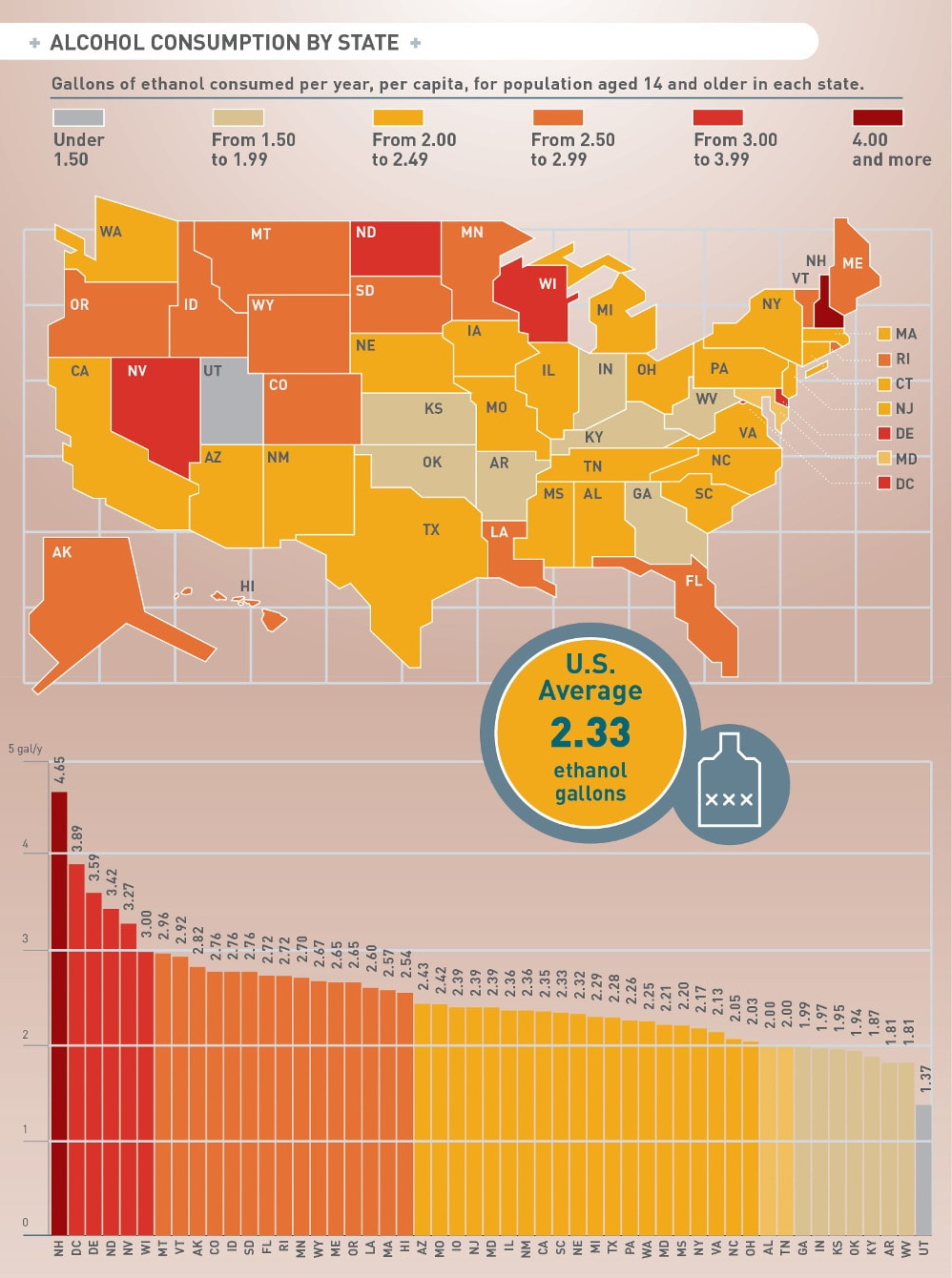Alcohol consumption in the United States varies significantly from state to state, influenced by a myriad of factors including cultural norms, economic conditions, and local legislation. The patterns of drinking not only reflect individual choices but also extend to societal issues such as public health, crime rates, and economic productivity. This exploration reveals the multifaceted dimensions of alcohol consumption across the United States, challenging us to consider the broader implications that these patterns have on our communities.
Understanding Alcohol Consumption Patterns
The act of drinking alcohol is steeped in cultural roots, often perceived as a rite of passage, a social lubricant, or a means of coping with life’s challenges. In the U.S., the landscape of alcohol consumption encompasses a wide range of behaviors and attitudes, reflecting divergent regional identities shaped by historical context and contemporary socioeconomic conditions.
Some states show a proclivity for higher per capita consumption, while others exhibit markedly lower levels, revealing stark contrasts in both consumption rates and societal acceptance of drinking. States like Vermont and New Hampshire, for instance, display higher average alcohol consumption compared to states such as Utah, which is characterized by its stricter regulations on alcohol sales and consumption, heavily influenced by the predominant values of the Latter-day Saints community.
Demographic factors play an integral role in shaping these consumption patterns. Age, gender, and socioeconomic status contribute significantly to who drinks, how much they consume, and in what context. For instance, the younger population tends to engage in binge drinking more frequently than older adults; meanwhile, socioeconomic status often dictates both access to alcohol and attitudes toward drinking.
The Penalty of Excess: Health Implications of High Consumption States
Elevated levels of alcohol consumption in various states do not occur without consequences. The ramifications manifest not only in terms of public health but also in economic costs, family dynamics, and social cohesion. States with high per capita alcohol consumption typically exhibit increased rates of alcohol-related illnesses, including liver disease, depression, and various forms of addiction.
Moreover, the correlation between alcohol consumption and criminal behavior serves as a stark reminder of the issues at hand. Higher instances of drunk driving, domestic violence, and alcohol-related accidents are often reported in states where consumption rates soar. Studies show that communities with elevated drinking rates experience challenges related to law enforcement and healthcare, as the ramifications of alcohol misuse ripple outward, affecting families, children, and social services.
Conversely, states like Utah that maintain lower per capita rates of alcohol consumption often experience fewer of these adverse outcomes. While the emphasis on abstinence has complex cultural roots, it provides an essential lens through which to examine the impact of consumption rates. The benefits of reduced alcohol consumption manifest in lower healthcare costs, reduced crime rates, and enhanced community well-being, posing a compelling argument for advocating for reduced drinking as a public health priority.
An Economic Perspective: The Cost of Alcohol
The impact of alcohol consumption extends beyond health outcomes and infiltrates the economic fabric of individual states. Taxes and revenue generated from alcohol sales can ostensibly contribute to state budgets; however, these financial benefits can quickly be overshadowed by the extensive costs associated with excessive drinking.
Healthcare expenses, law enforcement needs, and lost productivity collectively impose a substantial financial burden on states grappling with high consumption rates. For instance, the Centers for Disease Control and Prevention (CDC) estimates that excessive alcohol use costs the United States more than $249 billion annually, underscoring the need for a holistic approach to addressing excessive drinking.
Investing in prevention and education programs can serve as a remedy, curbing consumption while simultaneously improving long-term economic outcomes. States that prioritize awareness initiatives tend to report better health metrics and a reduction in alcohol-related incidents, ultimately saving resources allocated to crisis management.
Cultivating a Healthier Future: The Role of Policy
Legislation surrounding alcohol consumption demonstrates how policy can significantly influence drinking behaviors. States that have enacted strict regulations promote responsible drinking behaviors and the reduction of access to alcohol. For example, imposing higher taxes on alcoholic beverages often correlates with reduced consumption levels. Intentionally designed policies can engender a culture of moderation, steering consumers towards healthier choices.
Furthermore, the introduction of minimum drinking age laws, public education campaigns, and designated driver initiatives can characterize expansive efforts to mitigate the adverse effects of alcohol consumption. States that adopt such proactive stances often report a decline in alcohol-related fatalities and injuries, suggesting that policy serves as a valuable tool in fostering healthier community practices.
The Nexus of Culture and Consumption: A Call for Reflection
What emerges from the discussion on alcohol consumption among states is the necessity for a reflective examination of cultural attitudes toward drinking. How does society view alcohol? As a harmless social aid, as a necessary escape, or as a vice to be carefully regulated? These bottlenecks of perception shape the reality surrounding consumption, often downplaying the very real dangers posed by excessive drinking.
It is crucial to challenge the stereotype that associates alcohol with leisure and pleasure, emphasizing the need for a balanced approach to consumption. Social environments need to evolve from predominantly alcohol-centric gatherings to inclusive spaces that cater to a broader spectrum of preferences.
As we grapple with the discrepancies in alcohol consumption statistics across states, it becomes evident that no state can afford to ignore the intricate dynamics at play. The implications of consumption extend far beyond individual choices; they reflect on collective welfare.
Alcohol consumption is not merely a statistic; it entails human experiences and societal consequences, urging us to engage in a dialogue that promotes responsibility, awareness, and ultimately healthier communities.
